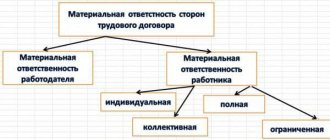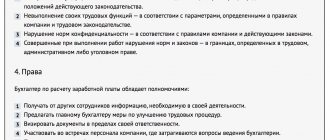Sample job description for an accountant
APPROVED by: General Director of Supply Wholesale LLC Shirokov /I.A. Shirokov/ August 12, 2014
Accountant job description
I. General provisions
1.1. This document regulates the following parameters relating to the activities of an accountant: job functions and tasks, working conditions, rights, powers, responsibilities.
1.2. The hiring and dismissal of an accountant occurs through the issuance by the management of the organization of a corresponding order or instruction and is regulated by the legislation of the Russian Federation in the field of labor.
1.3. The accountant's immediate superior is the chief accountant of the organization.
1.4. During the absence of an accountant from the workplace, his functions are transferred to a person who has the necessary knowledge, skills and competence and is appointed in accordance with the procedure established by internal rules.
1.5. Requirements for an accountant: education of at least secondary specialized education, with work experience of at least two years, or higher professional education with work experience of at least six months.
1.6. The accountant must be familiar with:
- basics of civil and labor legislation of the Russian Federation;
- basics of economics and management;
- internal regulations, labor protection rules; fire safety and other types of security at the enterprise;
- internal regulations, instructions, orders and other documentation directly related to the activities of the accountant;
- organizing the company's accounting workflow;
- templates, samples and forms of various forms and documents accepted in the organization, as well as rules for their preparation, systematization and storage;
- ways and methods of accounting and tax accounting and reporting.
1.7. An accountant must have:
- skills in maintaining and preparing accounting and tax accounting and reporting;
- methods of economic analysis of the organization's work;
- plans and correspondence of accounting accounts.
- skills in working with computers and computing equipment, the Microsoft Office software package, specialized accounting services, as well as all office equipment.
II. Job responsibilities of an accountant
2.1. The duties and responsibilities of an accountant include:
- conducting financial and economic transactions, accounting for liabilities and property, including registration of the acquisition and sale of products, items, inventory, etc.;
- accounting for cash flows, as well as reflecting processes and operations related to the finances of the enterprise on the organization’s accounting accounts;
- working with cash;
- registration, acceptance and issuance, as well as control over the movement of primary accounting documentation (invoices, acts, invoices, etc.);
- working with banks in which the company's current accounts are opened, including submitting payment orders to the bank, requests and receipt of statements, etc.;
- development of forms of accounting documents for registration of various financial and economic transactions, in the absence of their officially approved, mandatory samples;
- working with the tax base, calculating taxes and transferring them to budgets of various levels;
- calculation and transfer of insurance contributions to extra-budgetary funds (PFR, Social Insurance Fund, Compulsory Medical Insurance Fund);
- calculation of salaries and other payments to employees of the organization, incl. social in nature (financial assistance, bonuses, sick leave, vacation pay, business trips, etc.);
- preparation of accounting and tax reporting;
- regularly informing the immediate supervisor about current processes in accounting, as well as timely reports of all non-standard, complex, controversial situations;
- participation in activities to inventory the property and financial condition of the enterprise;
- participation in audits, tax and other inspections initiated by both the management of the enterprise and supervisory authorities;
- timely familiarization with amendments made by law to the rules of accounting and tax accounting and reporting at enterprises, as well as their application in practice;
III. Rights
3.1. The organization's accountant has the following powers and rights:
- make to management reasoned and substantiated written proposals for improving and optimizing the work of both yourself and the enterprise as a whole;
- participate in meetings, planning meetings, meetings, discussions and other events directly related to his activities;
- improve your professional level, including attending courses, seminars, webinars, conferences, trainings, etc.;
- request documents (including archival ones), teaching aids and other materials needed to solve current issues and problems;
- make constructive proposals to eliminate violations, errors, and shortcomings identified during the work;
- sign documents within his competence;
- refuse to perform work functions if there is a threat to life or health.
IV. Responsibility
Disciplinary liability threatens the accountant for the following actions:
4.1. Neglect of performing labor duties, including complete evasion of them.
4.2. Malicious, regular violation of the internal rules established at the enterprise, work and rest regime, discipline, as well as violation of any types of safety and other regulatory regulations.
4.3. Failure to comply with orders and instructions issued by the organization’s management or immediate supervisor.
4.4. Causing (intentional or unintentional) material damage to the company.
4.5. Disclosure of confidential information about the organization.
4.6. All the above points strictly comply with the current legislation of the Russian Federation.
V. Working conditions
5.1. An accountant must obey the company’s internal rules, which detail the conditions of his work.
5.2. If necessary, the accountant may be sent on business trips.
AGREED Deputy Director for Economic Affairs LLC “Supplies Wholesale” Sterkhov /Sterkhov R.A./ August 12, 2014
The instructions have been read by: Simonov Andrey Aleksandrovich Accountant LLC "Supplies Wholesale" Passport 2435 No. 453627 Issued by the Department of Internal Affairs of the Leninsky District of Perm on September 14, 2012 department code 123-425 Signature Simonov August 17, 2014
Basic provisions
1. An employee occupying the position in question is elevated to the rank of specialist.
Qualification Requirements
| Category | Requirements |
| I | Complete higher education in the Faculty of Economics. Minimum work experience as an accounting employee of category II 3 years |
| II | Completed university studies in the Faculty of Economics without work experience in the position in question or secondary specialized education in an economics specialty with a minimum work experience of 3 years |
| Accountant | Profile secondary education in an economic specialty with no minimum work experience or preparatory courses and a minimum work experience of 3 years |
2. Appointment and removal from office are made by decree of the chief accountant.
3. The guidelines for work are:
- the job document in question;
- instruction consistent with the focus of group work;
- regulations on the finance department;
- working group regulations.
4. The accountant’s knowledge extends to:
4. 1. Code of laws and other legal documents that proclaim work with finances.
4. 2. Targeted and strategic organizational progress.
4. 3. Profile orientation and internal structural diagram.
4. 4. The political component of finance, as well as strategic decisions for their implementation.
4. 5. Methodology of financial management.
4. 6. Plan and accounting correspondence.
4. 7. Streamlining document processing processes, as well as transparency of operations accompanied by the dynamics of underlying funds.
4. 8. Methods for analytical research of enterprise economics.
4. 9. Rules for handling documentation of the accounting department.
4. 10. Legal standards of labor protection.
5. The accountant must have the abilities and skills necessary to effectively perform the functions.
6. The subordination of an accounting employee is limited to the head of the financial department.
7. If an accountant is absent for an indefinite period of time, an accountant who is junior in position acts as his replacement.
Read and download also the job description: → accountant, → chief accountant, → deputy chief accountant, → payroll accountant, → economist, → human resources specialist.
Why do you need a job description?
This document is of great importance both for the management of the enterprise and for the accountants themselves. It allows the first to competently coordinate and manage the work of subordinates, and the second to clearly understand work functionality and responsibility. In addition, in the event of controversial situations that require resolution in court, the job description can serve as evidence of the presence or absence of guilt on the part of the employee or employer. The more carefully and accurately the requirements for the employee are spelled out, as well as his rights, responsibilities and other points of the job description, the better.
Basic rules for an accountant's job description
There is no unified form for this document, so enterprises can develop an accountant’s job description on their own. Due to the lack of an approved template, at different enterprises employees employed in the same positions may perform slightly different duties, although the main functions are still standard and similar.
The document is divided into four main parts:
- "General Provisions"
- "Job Responsibilities"
- "Rights",
- "Responsibility",
but, if desired, the management of the enterprise can add other sections.
The job description is drawn up in one copy, and if there are several accountants in the organization, then its copies are printed in an amount equal to the number of accountants. Each accountant whose functions correspond to the job responsibilities specified in the document must sign it. In the same way, each document must be certified by an employee who is responsible for compliance with the rules and functionality prescribed in the job description and the head of the organization.
Drawing up a job description for an accountant
The upper right part of the document is reserved for approval by the head of the enterprise. Here you should enter his position, name of the organization, last name, first name, patronymic, and also leave a line for signature with mandatory decoding. Then the title of the document is written in the center of the line.
Main part of the instructions
In the first section entitled “General Provisions” you must enter which category of employees the storekeeper belongs to (specialist, worker, technical staff, etc.), then indicate on the basis of what order the accountant is appointed, to whom he reports and who replaces him, in if necessary (there is no need to write specific names here, it is enough to indicate the positions of authorized employees). The next step is to enter into the document the qualification requirements that the accountant must meet (specialization, education, additional professional training), as well as length of service and work experience, with which the employee can be allowed to perform work functions.
Further in the same section you need to list all the regulations, rules, orders with which the accountant must be familiar: standards and forms of documents accepted in the organization, rules for maintaining accounts and correspondence, organization of accounting document flow, rules on safety, labor protection and internal schedule, etc.
Second section
The second section, “Job responsibilities of an accountant,” relates directly to the functions that are assigned to an accountant. They may be different at different enterprises, but they should always be described in as much detail as possible. If there are several accountants in an enterprise and they have different functions, you must carefully ensure that there is no duplication in job responsibilities.
Third section
“Rights” section includes the powers that an accountant is given to effectively perform his work. Here you can separately indicate his right to interact with the organization’s management and other employees, as well as representatives of other structures if such a need arises. Rights must be spelled out in the same way as responsibilities - accurately and clearly.
Fourth section
“Responsibility” section establishes specific violations by the accountant, for which internal sanctions and penalties are provided. In one of the paragraphs, it is necessary to indicate that the applied measures comply with the framework of the law and the Labor Code of the Russian Federation.
Fifth section
The last section of the job description includes “Working conditions” - in particular, how they are determined (for example, internal labor regulations), as well as any features, if any.
Finally, the document must be agreed upon with the employee who is responsible for compliance with the rules and regulations prescribed in the accountant’s job description (this may be the immediate supervisor, the head of the human resources department, etc.). Here you need to enter his position, name of the organization, last name, first name, patronymic, as well as put a signature and be sure to decipher it.
Below you must provide information about the accountant :
- his last name, first name, patronymic (in full),
- Name of the organization,
- passport details,
- signature,
- date of familiarization with the document.
There is no need to put a stamp on the job description.
II. Job responsibilities
The responsibilities of an accountant include:
1. Acceptance for accounting of primary accounting documents on the facts of the economic life of an economic entity:
— Drawing up (registration) of primary accounting documents
— Reception of primary accounting documents on the facts of the economic life of an economic entity
— Identifying cases of violation by responsible persons of the document flow schedule and the procedure for submitting primary accounting documents to the accounting service and informing the head of the accounting service about this
— Checking primary accounting documents regarding form, completeness, details
— Systematization of primary accounting documents of the current reporting period in accordance with accounting policies
— Drawing up consolidated accounting documents based on primary accounting documents
— Preparation of primary accounting documents for transfer to the archive
— Making copies of primary accounting documents, including in case of their seizure by authorized bodies in accordance with the legislation of the Russian Federation
— Providing data for conducting an inventory of assets and liabilities of an economic entity in accordance with the accounting policies of the economic entity
2. Monetary measurement of accounting objects and the current grouping of facts of economic life:
— Monetary measurement of accounting objects and the implementation of corresponding accounting entries
— Registration of data contained in primary accounting documents in accounting registers
— Reflection in accounting of the results of revaluation of accounting objects, recalculation into rubles of the value of assets and liabilities expressed in foreign currency
— Drawing up reporting calculations, calculations of the cost of products (works, services), distribution of indirect costs, calculation of depreciation of assets in accordance with the accounting policy of an economic entity
— Comparison of inventory results with data from accounting registers and preparation of reconciliation statements
3. Final summary of the facts of economic life:
— Calculation of totals and balances of synthetic and analytical accounts in accounting registers, closing of turnovers in accounting accounts
— Control of the identity of analytical accounting data with turnovers and balances on synthetic accounting accounts
— Preparation of balance sheet and general ledger
— Preparation of explanations, selection of necessary documents for internal control, state (municipal) financial control, internal and external audit, audits, tax and other inspections
— Providing accounting registers for their seizure by authorized bodies in accordance with the legislation of the Russian Federation
— Systematization and completion of accounting registers for the reporting period
— Transfer of accounting registers to the archive
— Production and provision, upon request of authorized bodies, of copies of accounting registers
— Reflection in accounting of identified discrepancies between the actual availability of objects and the data of accounting registers







